R.V.R. & J.C. College: PMEDM Optimization Project, Mechanical Engg.
VerifiedAdded on 2022/08/27
|10
|1767
|29
Project
AI Summary
This project report details the application of Response Surface Methodology (RSM) and Desirability approach for optimizing the parameters of Powder Mixed Electrical Discharge Machining (PMEDM) on CK45 heat-treated steel using a copper electrode. The project aimed to optimize surface roughness (SR) and material removal rate (MRR). The student, acting as the chief project developer, conducted experiments, analyzed data using ANOVA, and applied RSM and the Desirability approach to identify optimal parameters. The report includes details of the experimental setup, the theoretical background of PMEDM, the objectives of the project, the student's role and responsibilities, and the challenges faced. The results revealed the significant influence of peak current and concentration on SR and MRR. The study successfully applied RSM and the Desirability approach for improving the multi-performance characteristics of SR and MRR within silicon PMEDM.
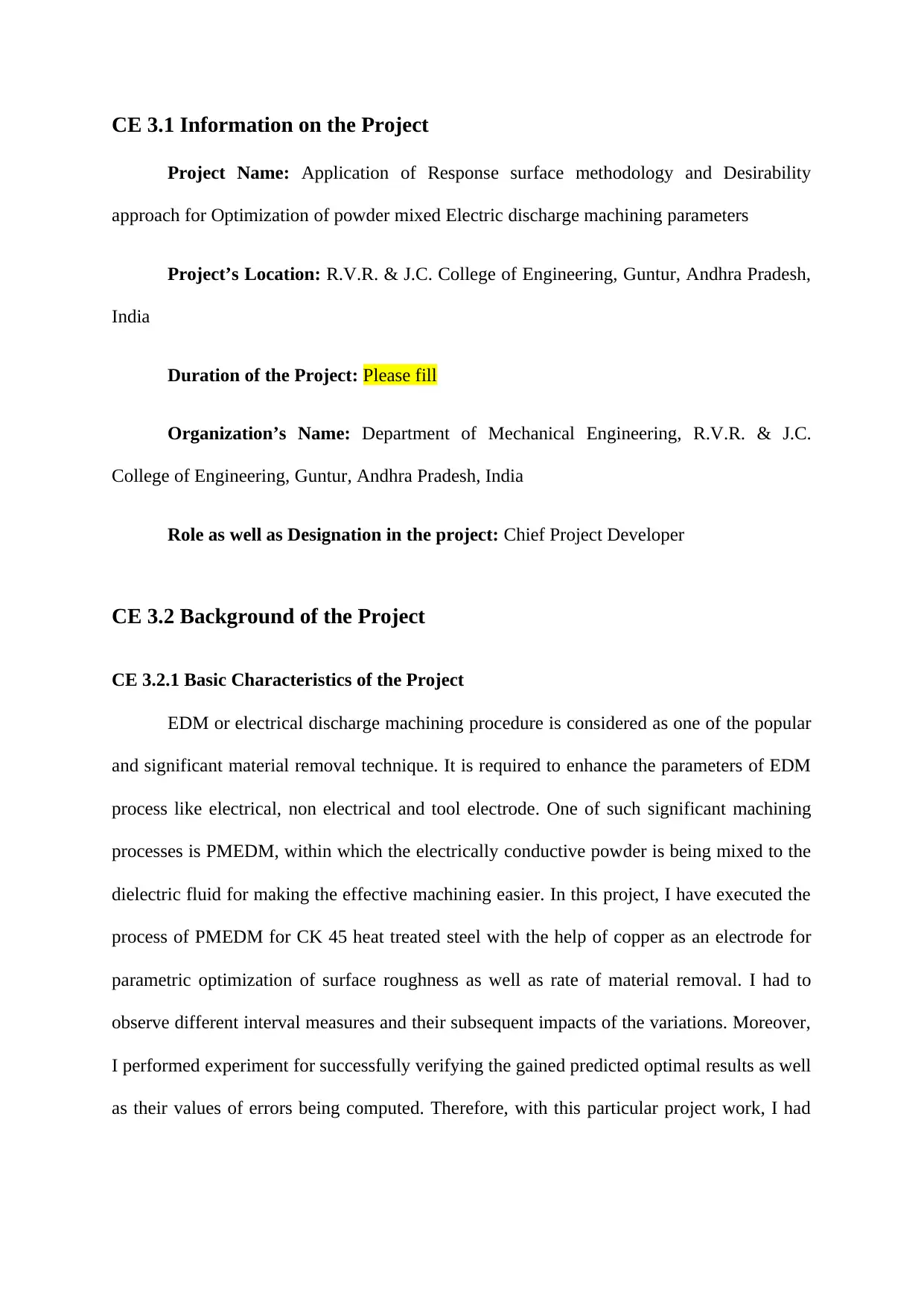
CE 3.1 Information on the Project
Project Name: Application of Response surface methodology and Desirability
approach for Optimization of powder mixed Electric discharge machining parameters
Project’s Location: R.V.R. & J.C. College of Engineering, Guntur, Andhra Pradesh,
India
Duration of the Project: Please fill
Organization’s Name: Department of Mechanical Engineering, R.V.R. & J.C.
College of Engineering, Guntur, Andhra Pradesh, India
Role as well as Designation in the project: Chief Project Developer
CE 3.2 Background of the Project
CE 3.2.1 Basic Characteristics of the Project
EDM or electrical discharge machining procedure is considered as one of the popular
and significant material removal technique. It is required to enhance the parameters of EDM
process like electrical, non electrical and tool electrode. One of such significant machining
processes is PMEDM, within which the electrically conductive powder is being mixed to the
dielectric fluid for making the effective machining easier. In this project, I have executed the
process of PMEDM for CK 45 heat treated steel with the help of copper as an electrode for
parametric optimization of surface roughness as well as rate of material removal. I had to
observe different interval measures and their subsequent impacts of the variations. Moreover,
I performed experiment for successfully verifying the gained predicted optimal results as well
as their values of errors being computed. Therefore, with this particular project work, I had
Project Name: Application of Response surface methodology and Desirability
approach for Optimization of powder mixed Electric discharge machining parameters
Project’s Location: R.V.R. & J.C. College of Engineering, Guntur, Andhra Pradesh,
India
Duration of the Project: Please fill
Organization’s Name: Department of Mechanical Engineering, R.V.R. & J.C.
College of Engineering, Guntur, Andhra Pradesh, India
Role as well as Designation in the project: Chief Project Developer
CE 3.2 Background of the Project
CE 3.2.1 Basic Characteristics of the Project
EDM or electrical discharge machining procedure is considered as one of the popular
and significant material removal technique. It is required to enhance the parameters of EDM
process like electrical, non electrical and tool electrode. One of such significant machining
processes is PMEDM, within which the electrically conductive powder is being mixed to the
dielectric fluid for making the effective machining easier. In this project, I have executed the
process of PMEDM for CK 45 heat treated steel with the help of copper as an electrode for
parametric optimization of surface roughness as well as rate of material removal. I had to
observe different interval measures and their subsequent impacts of the variations. Moreover,
I performed experiment for successfully verifying the gained predicted optimal results as well
as their values of errors being computed. Therefore, with this particular project work, I had
Paraphrase This Document
Need a fresh take? Get an instant paraphrase of this document with our AI Paraphraser
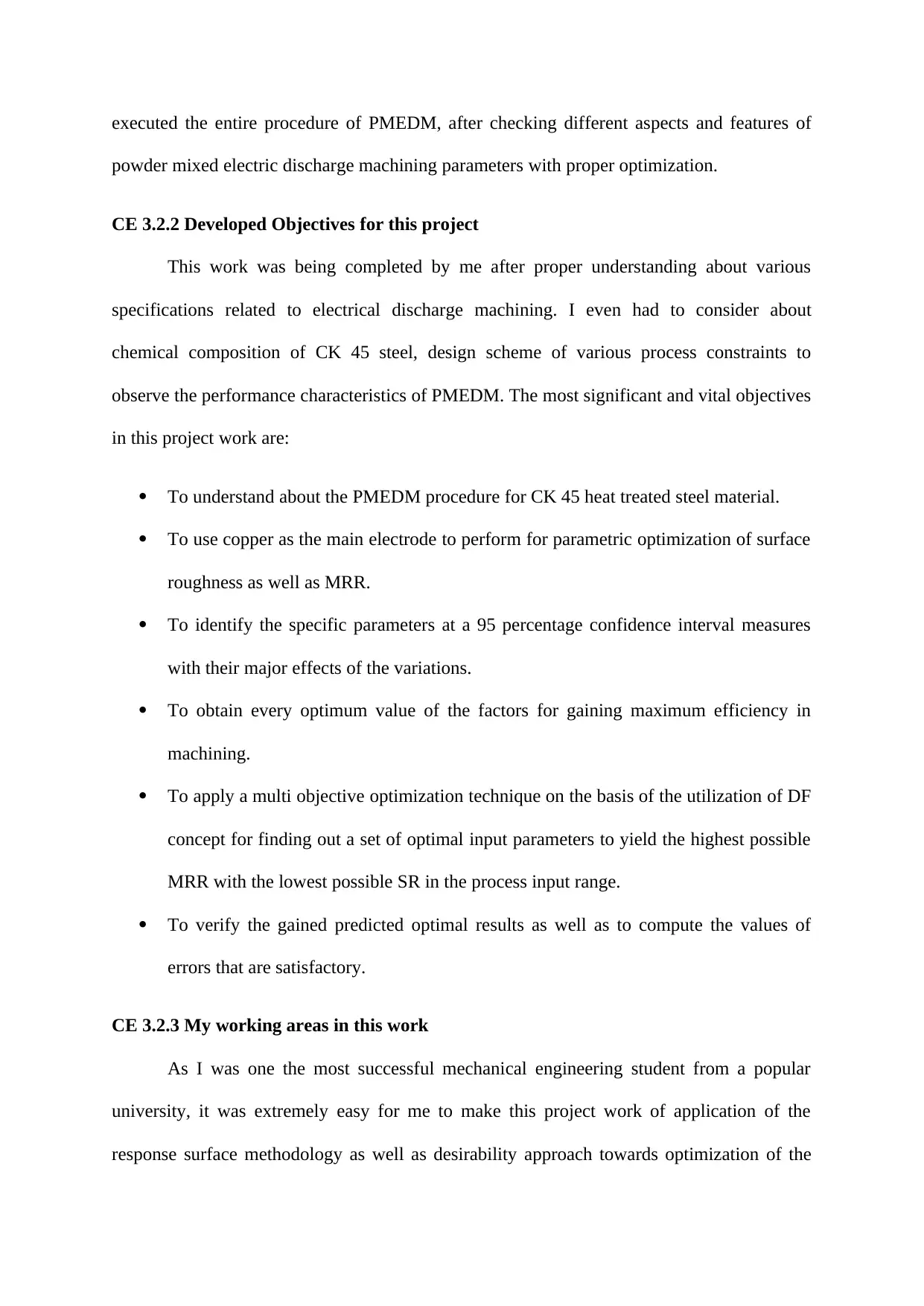
executed the entire procedure of PMEDM, after checking different aspects and features of
powder mixed electric discharge machining parameters with proper optimization.
CE 3.2.2 Developed Objectives for this project
This work was being completed by me after proper understanding about various
specifications related to electrical discharge machining. I even had to consider about
chemical composition of CK 45 steel, design scheme of various process constraints to
observe the performance characteristics of PMEDM. The most significant and vital objectives
in this project work are:
To understand about the PMEDM procedure for CK 45 heat treated steel material.
To use copper as the main electrode to perform for parametric optimization of surface
roughness as well as MRR.
To identify the specific parameters at a 95 percentage confidence interval measures
with their major effects of the variations.
To obtain every optimum value of the factors for gaining maximum efficiency in
machining.
To apply a multi objective optimization technique on the basis of the utilization of DF
concept for finding out a set of optimal input parameters to yield the highest possible
MRR with the lowest possible SR in the process input range.
To verify the gained predicted optimal results as well as to compute the values of
errors that are satisfactory.
CE 3.2.3 My working areas in this work
As I was one the most successful mechanical engineering student from a popular
university, it was extremely easy for me to make this project work of application of the
response surface methodology as well as desirability approach towards optimization of the
powder mixed electric discharge machining parameters with proper optimization.
CE 3.2.2 Developed Objectives for this project
This work was being completed by me after proper understanding about various
specifications related to electrical discharge machining. I even had to consider about
chemical composition of CK 45 steel, design scheme of various process constraints to
observe the performance characteristics of PMEDM. The most significant and vital objectives
in this project work are:
To understand about the PMEDM procedure for CK 45 heat treated steel material.
To use copper as the main electrode to perform for parametric optimization of surface
roughness as well as MRR.
To identify the specific parameters at a 95 percentage confidence interval measures
with their major effects of the variations.
To obtain every optimum value of the factors for gaining maximum efficiency in
machining.
To apply a multi objective optimization technique on the basis of the utilization of DF
concept for finding out a set of optimal input parameters to yield the highest possible
MRR with the lowest possible SR in the process input range.
To verify the gained predicted optimal results as well as to compute the values of
errors that are satisfactory.
CE 3.2.3 My working areas in this work
As I was one the most successful mechanical engineering student from a popular
university, it was extremely easy for me to make this project work of application of the
response surface methodology as well as desirability approach towards optimization of the
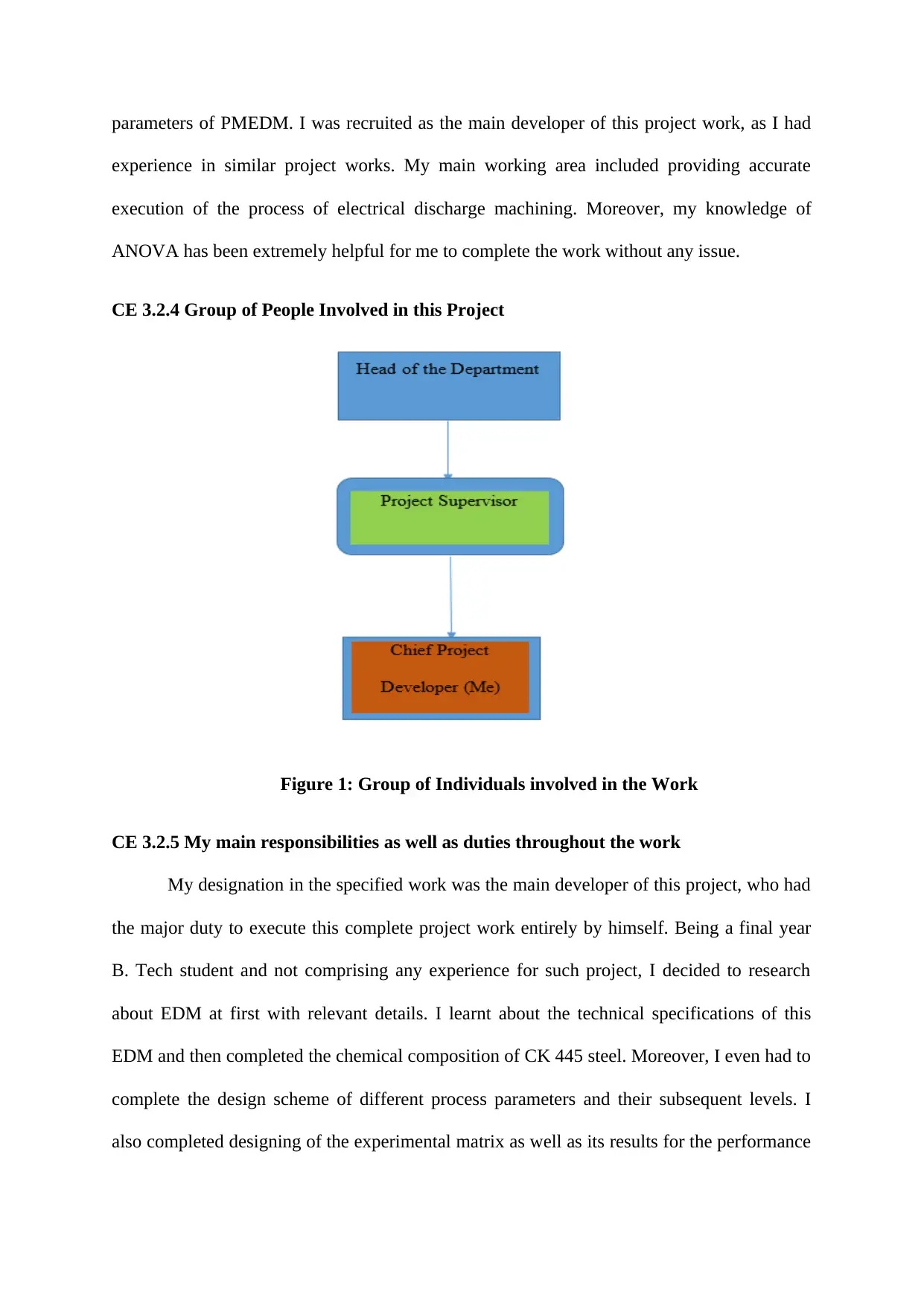
parameters of PMEDM. I was recruited as the main developer of this project work, as I had
experience in similar project works. My main working area included providing accurate
execution of the process of electrical discharge machining. Moreover, my knowledge of
ANOVA has been extremely helpful for me to complete the work without any issue.
CE 3.2.4 Group of People Involved in this Project
Figure 1: Group of Individuals involved in the Work
CE 3.2.5 My main responsibilities as well as duties throughout the work
My designation in the specified work was the main developer of this project, who had
the major duty to execute this complete project work entirely by himself. Being a final year
B. Tech student and not comprising any experience for such project, I decided to research
about EDM at first with relevant details. I learnt about the technical specifications of this
EDM and then completed the chemical composition of CK 445 steel. Moreover, I even had to
complete the design scheme of different process parameters and their subsequent levels. I
also completed designing of the experimental matrix as well as its results for the performance
experience in similar project works. My main working area included providing accurate
execution of the process of electrical discharge machining. Moreover, my knowledge of
ANOVA has been extremely helpful for me to complete the work without any issue.
CE 3.2.4 Group of People Involved in this Project
Figure 1: Group of Individuals involved in the Work
CE 3.2.5 My main responsibilities as well as duties throughout the work
My designation in the specified work was the main developer of this project, who had
the major duty to execute this complete project work entirely by himself. Being a final year
B. Tech student and not comprising any experience for such project, I decided to research
about EDM at first with relevant details. I learnt about the technical specifications of this
EDM and then completed the chemical composition of CK 445 steel. Moreover, I even had to
complete the design scheme of different process parameters and their subsequent levels. I
also completed designing of the experimental matrix as well as its results for the performance
⊘ This is a preview!⊘
Do you want full access?
Subscribe today to unlock all pages.

Trusted by 1+ million students worldwide
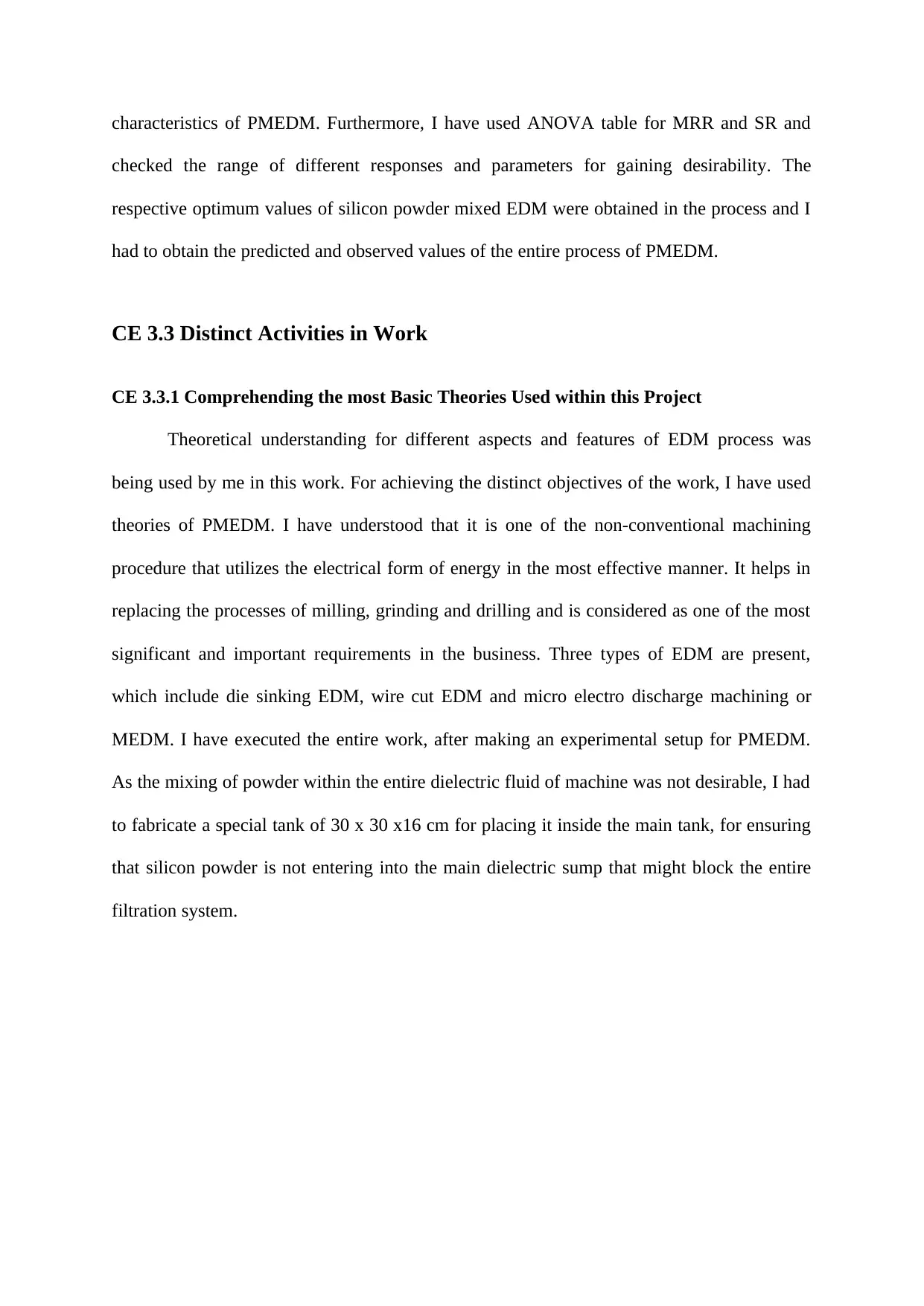
characteristics of PMEDM. Furthermore, I have used ANOVA table for MRR and SR and
checked the range of different responses and parameters for gaining desirability. The
respective optimum values of silicon powder mixed EDM were obtained in the process and I
had to obtain the predicted and observed values of the entire process of PMEDM.
CE 3.3 Distinct Activities in Work
CE 3.3.1 Comprehending the most Basic Theories Used within this Project
Theoretical understanding for different aspects and features of EDM process was
being used by me in this work. For achieving the distinct objectives of the work, I have used
theories of PMEDM. I have understood that it is one of the non-conventional machining
procedure that utilizes the electrical form of energy in the most effective manner. It helps in
replacing the processes of milling, grinding and drilling and is considered as one of the most
significant and important requirements in the business. Three types of EDM are present,
which include die sinking EDM, wire cut EDM and micro electro discharge machining or
MEDM. I have executed the entire work, after making an experimental setup for PMEDM.
As the mixing of powder within the entire dielectric fluid of machine was not desirable, I had
to fabricate a special tank of 30 x 30 x16 cm for placing it inside the main tank, for ensuring
that silicon powder is not entering into the main dielectric sump that might block the entire
filtration system.
checked the range of different responses and parameters for gaining desirability. The
respective optimum values of silicon powder mixed EDM were obtained in the process and I
had to obtain the predicted and observed values of the entire process of PMEDM.
CE 3.3 Distinct Activities in Work
CE 3.3.1 Comprehending the most Basic Theories Used within this Project
Theoretical understanding for different aspects and features of EDM process was
being used by me in this work. For achieving the distinct objectives of the work, I have used
theories of PMEDM. I have understood that it is one of the non-conventional machining
procedure that utilizes the electrical form of energy in the most effective manner. It helps in
replacing the processes of milling, grinding and drilling and is considered as one of the most
significant and important requirements in the business. Three types of EDM are present,
which include die sinking EDM, wire cut EDM and micro electro discharge machining or
MEDM. I have executed the entire work, after making an experimental setup for PMEDM.
As the mixing of powder within the entire dielectric fluid of machine was not desirable, I had
to fabricate a special tank of 30 x 30 x16 cm for placing it inside the main tank, for ensuring
that silicon powder is not entering into the main dielectric sump that might block the entire
filtration system.
Paraphrase This Document
Need a fresh take? Get an instant paraphrase of this document with our AI Paraphraser
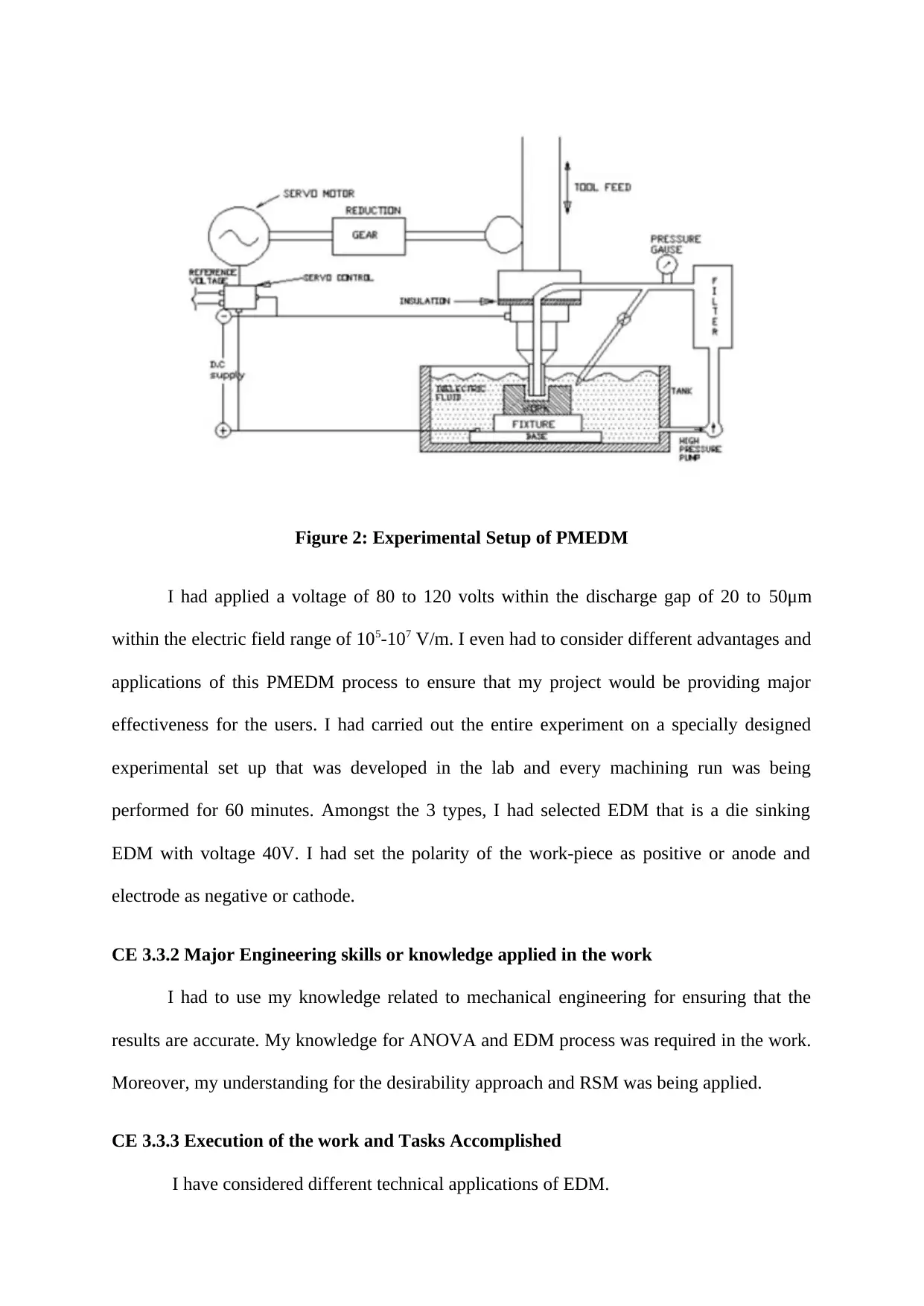
Figure 2: Experimental Setup of PMEDM
I had applied a voltage of 80 to 120 volts within the discharge gap of 20 to 50μm
within the electric field range of 105-107 V/m. I even had to consider different advantages and
applications of this PMEDM process to ensure that my project would be providing major
effectiveness for the users. I had carried out the entire experiment on a specially designed
experimental set up that was developed in the lab and every machining run was being
performed for 60 minutes. Amongst the 3 types, I had selected EDM that is a die sinking
EDM with voltage 40V. I had set the polarity of the work-piece as positive or anode and
electrode as negative or cathode.
CE 3.3.2 Major Engineering skills or knowledge applied in the work
I had to use my knowledge related to mechanical engineering for ensuring that the
results are accurate. My knowledge for ANOVA and EDM process was required in the work.
Moreover, my understanding for the desirability approach and RSM was being applied.
CE 3.3.3 Execution of the work and Tasks Accomplished
I have considered different technical applications of EDM.
I had applied a voltage of 80 to 120 volts within the discharge gap of 20 to 50μm
within the electric field range of 105-107 V/m. I even had to consider different advantages and
applications of this PMEDM process to ensure that my project would be providing major
effectiveness for the users. I had carried out the entire experiment on a specially designed
experimental set up that was developed in the lab and every machining run was being
performed for 60 minutes. Amongst the 3 types, I had selected EDM that is a die sinking
EDM with voltage 40V. I had set the polarity of the work-piece as positive or anode and
electrode as negative or cathode.
CE 3.3.2 Major Engineering skills or knowledge applied in the work
I had to use my knowledge related to mechanical engineering for ensuring that the
results are accurate. My knowledge for ANOVA and EDM process was required in the work.
Moreover, my understanding for the desirability approach and RSM was being applied.
CE 3.3.3 Execution of the work and Tasks Accomplished
I have considered different technical applications of EDM.
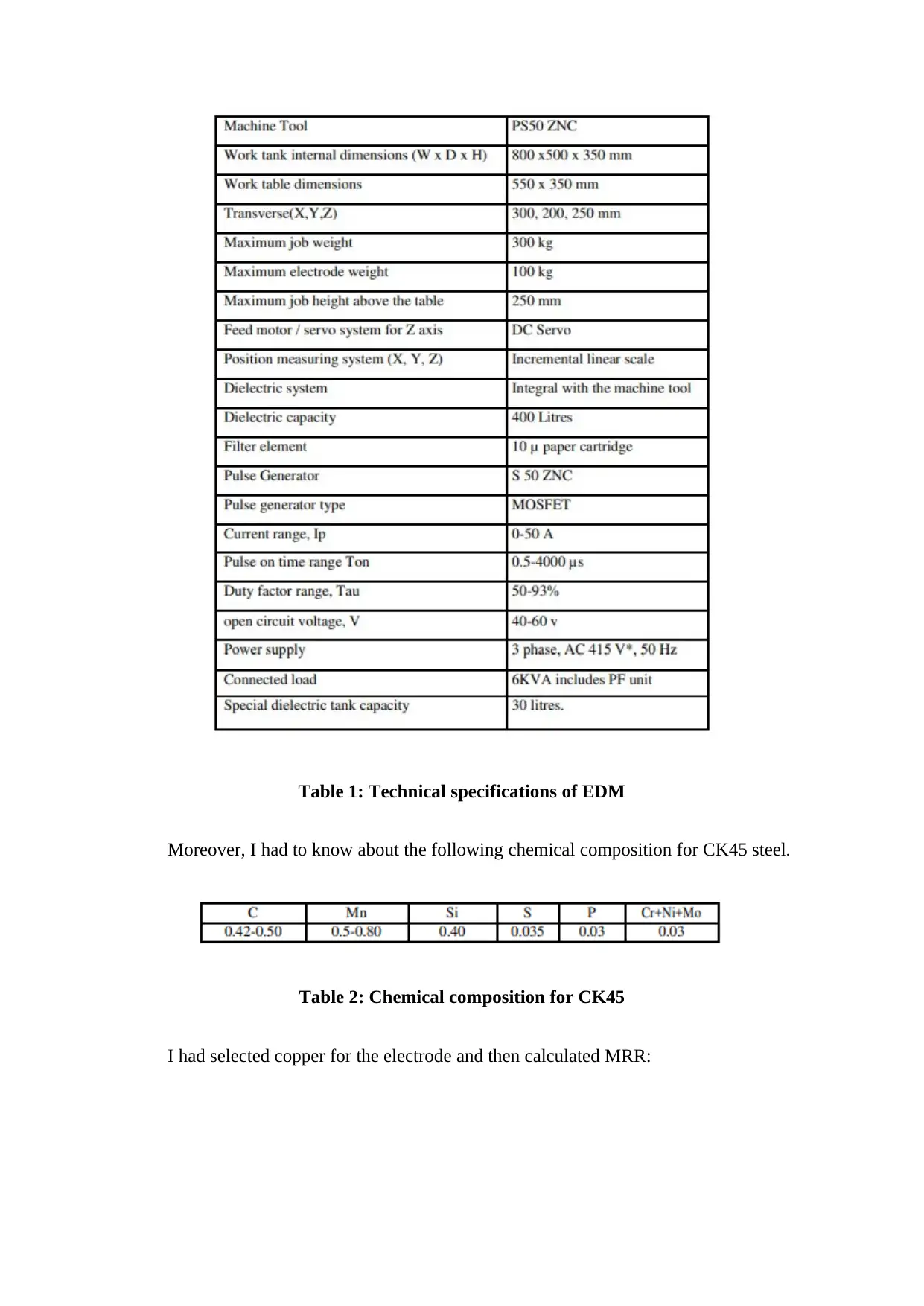
Table 1: Technical specifications of EDM
Moreover, I had to know about the following chemical composition for CK45 steel.
Table 2: Chemical composition for CK45
I had selected copper for the electrode and then calculated MRR:
Moreover, I had to know about the following chemical composition for CK45 steel.
Table 2: Chemical composition for CK45
I had selected copper for the electrode and then calculated MRR:
⊘ This is a preview!⊘
Do you want full access?
Subscribe today to unlock all pages.

Trusted by 1+ million students worldwide
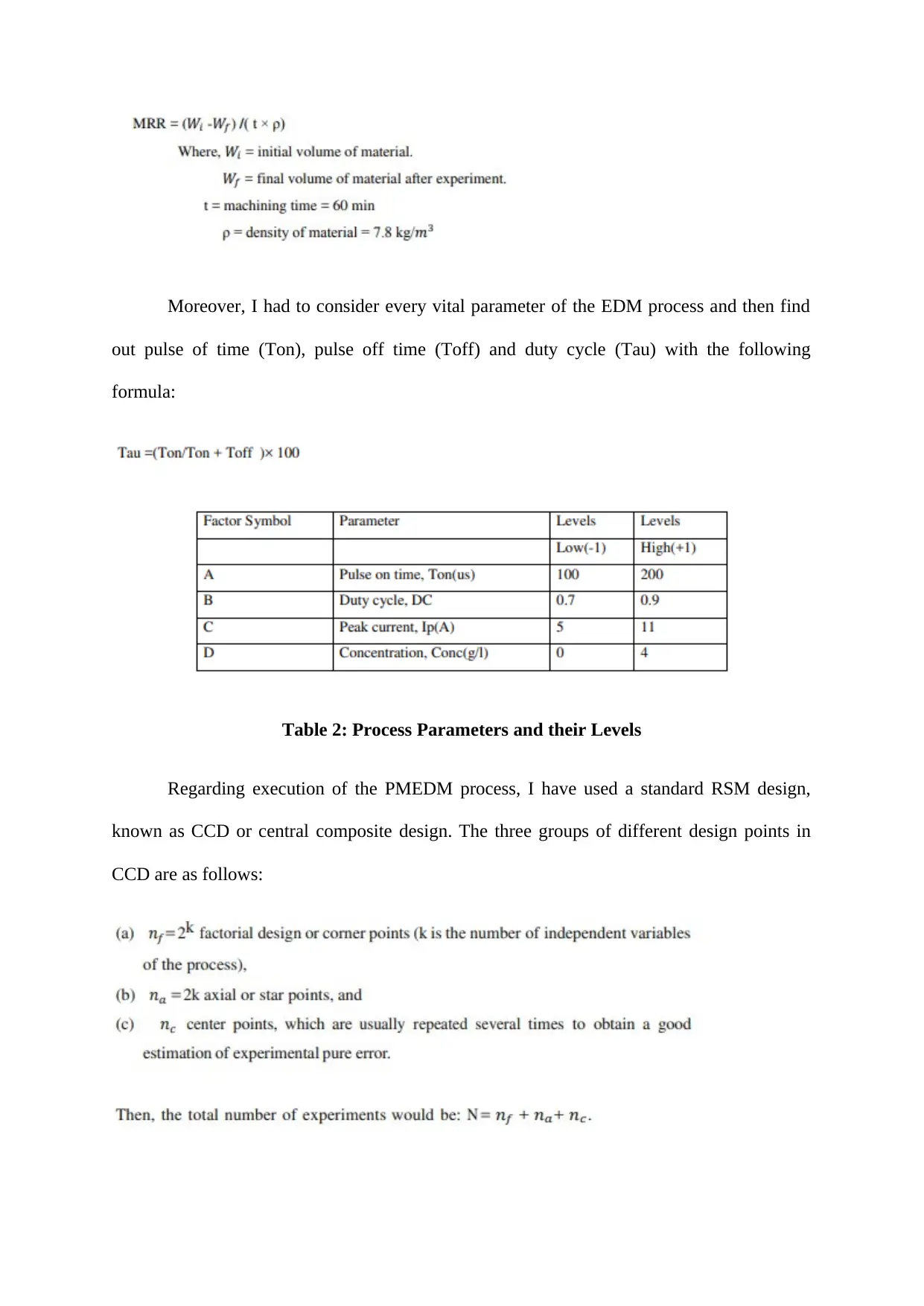
Moreover, I had to consider every vital parameter of the EDM process and then find
out pulse of time (Ton), pulse off time (Toff) and duty cycle (Tau) with the following
formula:
Table 2: Process Parameters and their Levels
Regarding execution of the PMEDM process, I have used a standard RSM design,
known as CCD or central composite design. The three groups of different design points in
CCD are as follows:
out pulse of time (Ton), pulse off time (Toff) and duty cycle (Tau) with the following
formula:
Table 2: Process Parameters and their Levels
Regarding execution of the PMEDM process, I have used a standard RSM design,
known as CCD or central composite design. The three groups of different design points in
CCD are as follows:
Paraphrase This Document
Need a fresh take? Get an instant paraphrase of this document with our AI Paraphraser
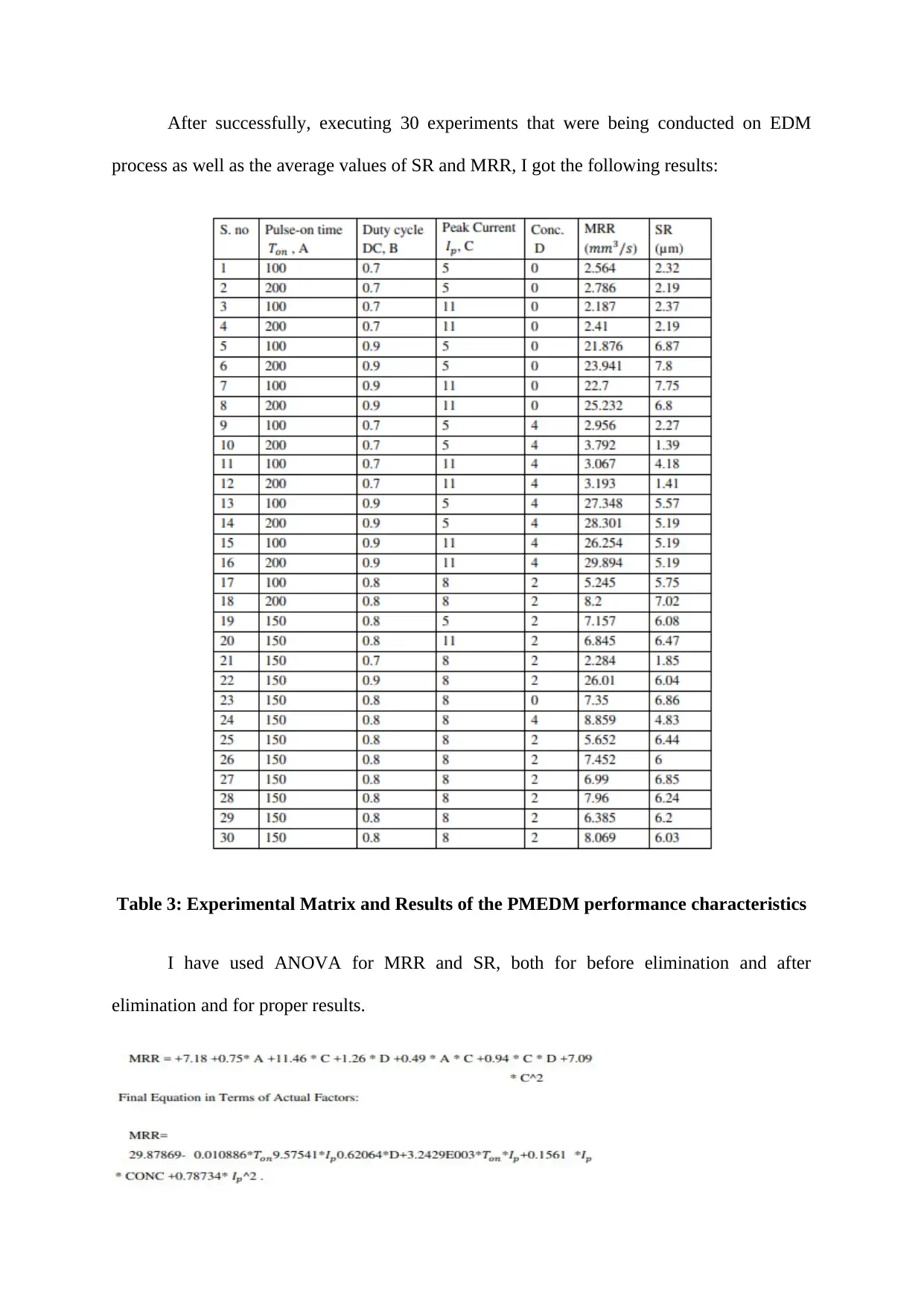
After successfully, executing 30 experiments that were being conducted on EDM
process as well as the average values of SR and MRR, I got the following results:
Table 3: Experimental Matrix and Results of the PMEDM performance characteristics
I have used ANOVA for MRR and SR, both for before elimination and after
elimination and for proper results.
process as well as the average values of SR and MRR, I got the following results:
Table 3: Experimental Matrix and Results of the PMEDM performance characteristics
I have used ANOVA for MRR and SR, both for before elimination and after
elimination and for proper results.
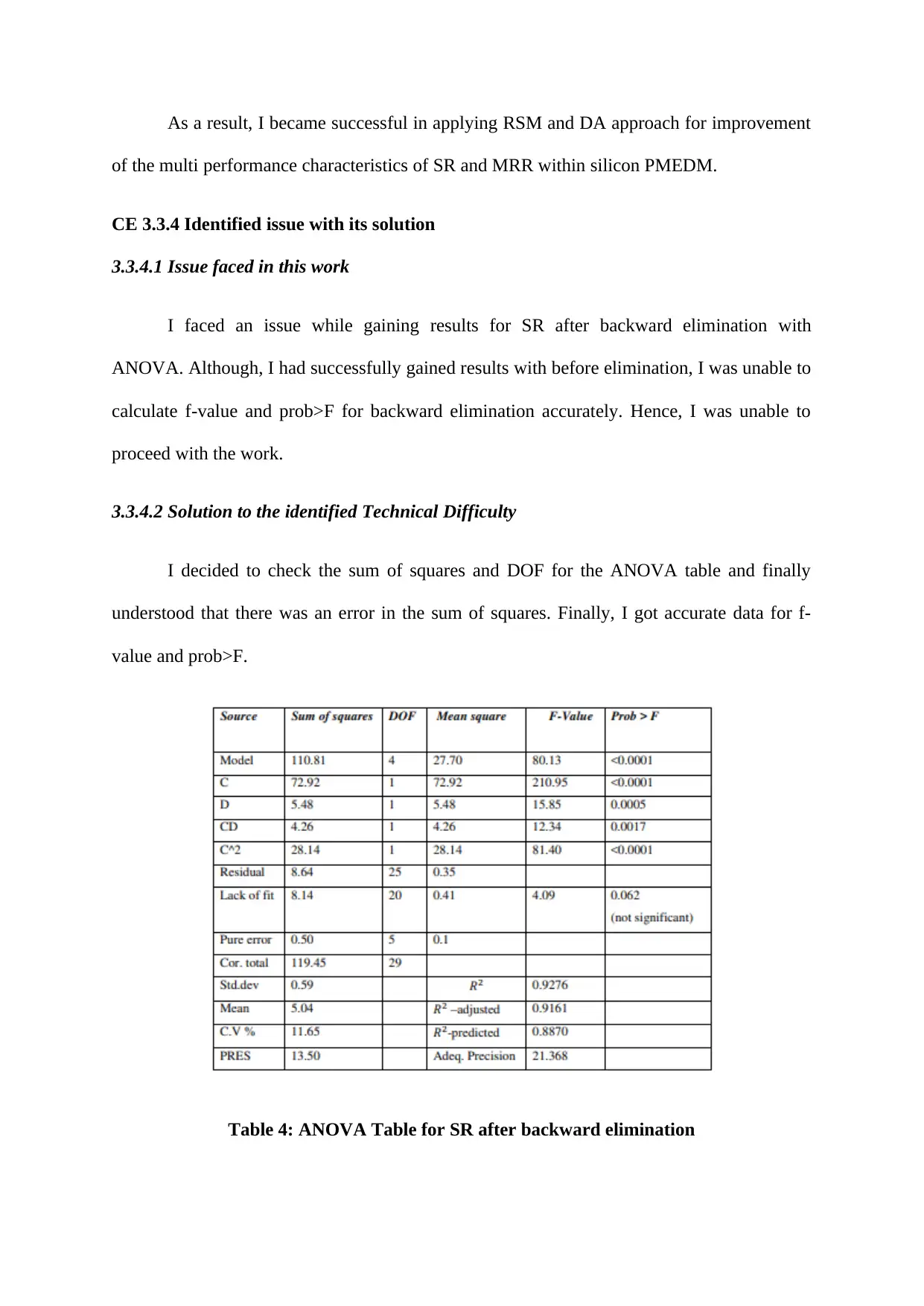
As a result, I became successful in applying RSM and DA approach for improvement
of the multi performance characteristics of SR and MRR within silicon PMEDM.
CE 3.3.4 Identified issue with its solution
3.3.4.1 Issue faced in this work
I faced an issue while gaining results for SR after backward elimination with
ANOVA. Although, I had successfully gained results with before elimination, I was unable to
calculate f-value and prob>F for backward elimination accurately. Hence, I was unable to
proceed with the work.
3.3.4.2 Solution to the identified Technical Difficulty
I decided to check the sum of squares and DOF for the ANOVA table and finally
understood that there was an error in the sum of squares. Finally, I got accurate data for f-
value and prob>F.
Table 4: ANOVA Table for SR after backward elimination
of the multi performance characteristics of SR and MRR within silicon PMEDM.
CE 3.3.4 Identified issue with its solution
3.3.4.1 Issue faced in this work
I faced an issue while gaining results for SR after backward elimination with
ANOVA. Although, I had successfully gained results with before elimination, I was unable to
calculate f-value and prob>F for backward elimination accurately. Hence, I was unable to
proceed with the work.
3.3.4.2 Solution to the identified Technical Difficulty
I decided to check the sum of squares and DOF for the ANOVA table and finally
understood that there was an error in the sum of squares. Finally, I got accurate data for f-
value and prob>F.
Table 4: ANOVA Table for SR after backward elimination
⊘ This is a preview!⊘
Do you want full access?
Subscribe today to unlock all pages.

Trusted by 1+ million students worldwide
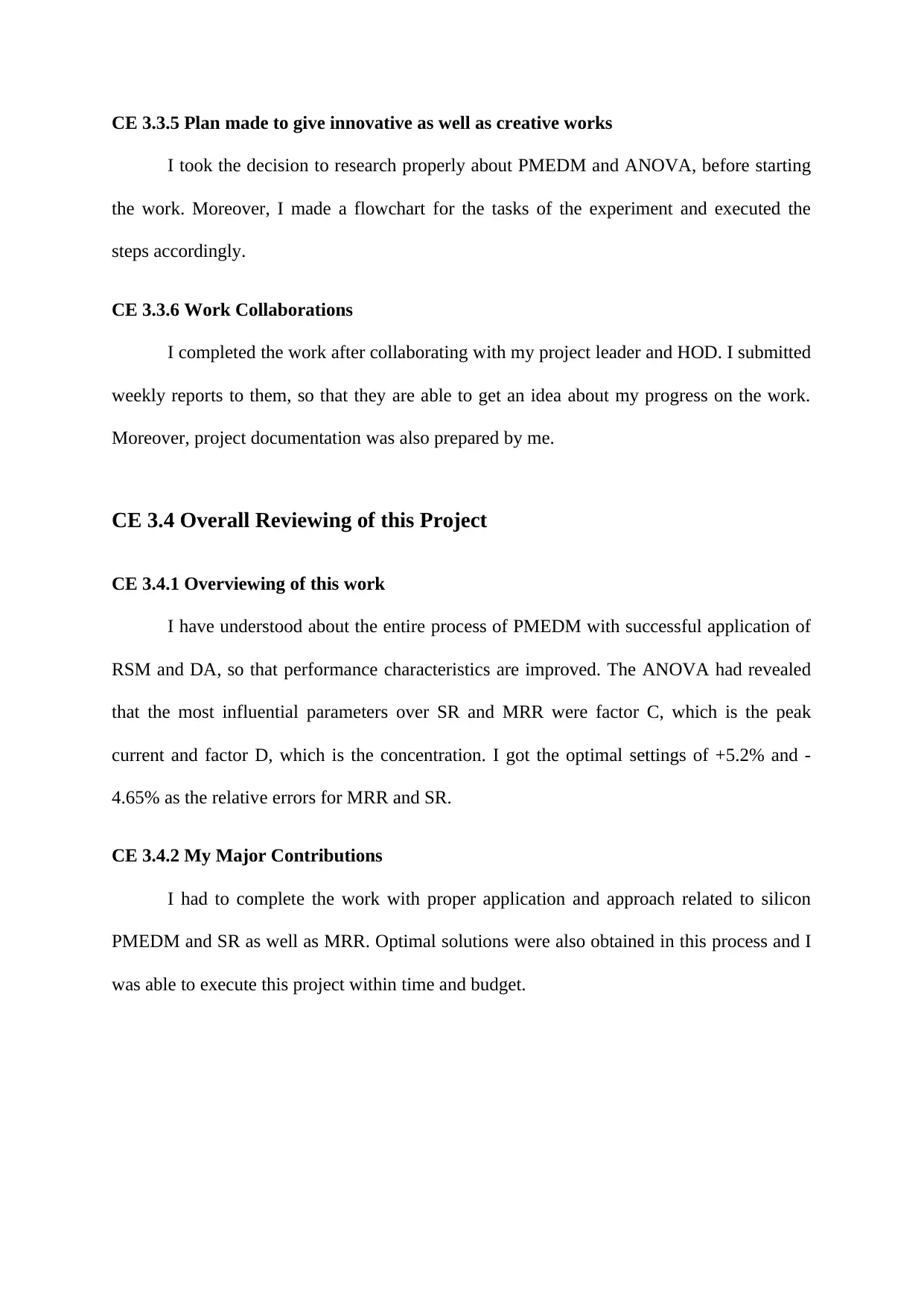
CE 3.3.5 Plan made to give innovative as well as creative works
I took the decision to research properly about PMEDM and ANOVA, before starting
the work. Moreover, I made a flowchart for the tasks of the experiment and executed the
steps accordingly.
CE 3.3.6 Work Collaborations
I completed the work after collaborating with my project leader and HOD. I submitted
weekly reports to them, so that they are able to get an idea about my progress on the work.
Moreover, project documentation was also prepared by me.
CE 3.4 Overall Reviewing of this Project
CE 3.4.1 Overviewing of this work
I have understood about the entire process of PMEDM with successful application of
RSM and DA, so that performance characteristics are improved. The ANOVA had revealed
that the most influential parameters over SR and MRR were factor C, which is the peak
current and factor D, which is the concentration. I got the optimal settings of +5.2% and -
4.65% as the relative errors for MRR and SR.
CE 3.4.2 My Major Contributions
I had to complete the work with proper application and approach related to silicon
PMEDM and SR as well as MRR. Optimal solutions were also obtained in this process and I
was able to execute this project within time and budget.
I took the decision to research properly about PMEDM and ANOVA, before starting
the work. Moreover, I made a flowchart for the tasks of the experiment and executed the
steps accordingly.
CE 3.3.6 Work Collaborations
I completed the work after collaborating with my project leader and HOD. I submitted
weekly reports to them, so that they are able to get an idea about my progress on the work.
Moreover, project documentation was also prepared by me.
CE 3.4 Overall Reviewing of this Project
CE 3.4.1 Overviewing of this work
I have understood about the entire process of PMEDM with successful application of
RSM and DA, so that performance characteristics are improved. The ANOVA had revealed
that the most influential parameters over SR and MRR were factor C, which is the peak
current and factor D, which is the concentration. I got the optimal settings of +5.2% and -
4.65% as the relative errors for MRR and SR.
CE 3.4.2 My Major Contributions
I had to complete the work with proper application and approach related to silicon
PMEDM and SR as well as MRR. Optimal solutions were also obtained in this process and I
was able to execute this project within time and budget.
1 out of 10
Your All-in-One AI-Powered Toolkit for Academic Success.
+13062052269
info@desklib.com
Available 24*7 on WhatsApp / Email
![[object Object]](/_next/static/media/star-bottom.7253800d.svg)
Unlock your academic potential
Copyright © 2020–2025 A2Z Services. All Rights Reserved. Developed and managed by ZUCOL.
